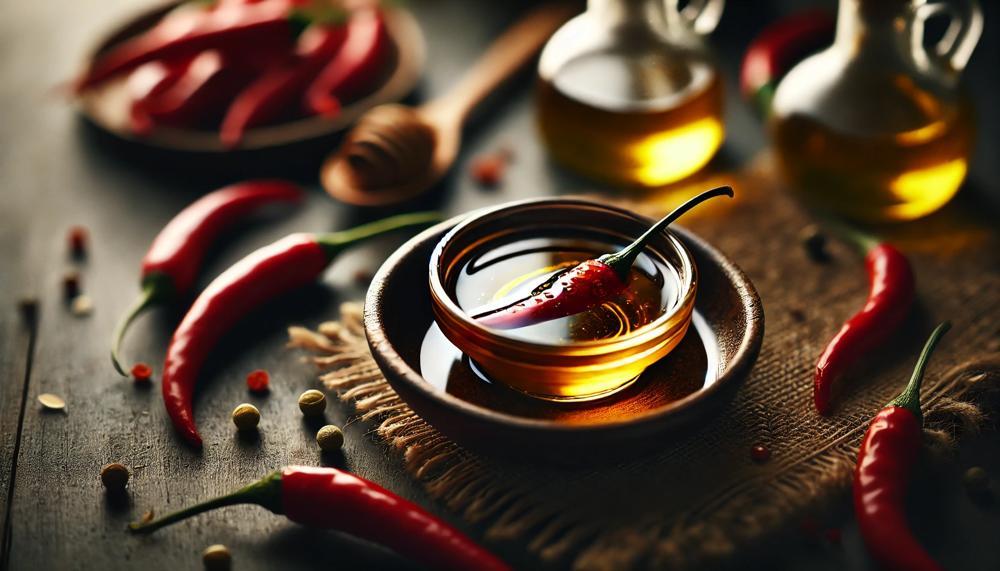Yes, you should refrigerate chili oil, but it depends on a few factors. Let’s dive into why:
Imagine you’re savoring your favorite dish, drizzled with that perfect spicy kick from your homemade chili oil. Now, the last thing you want is for that flavor to go off or, worse, make you sick. Proper storage of chili oil isn’t just about maintaining taste—it’s about ensuring safety and longevity. Here’s why you might want to refrigerate your chili oil, especially if it’s homemade:
- Homemade Chili Oil: Without preservatives, it can spoil faster. Refrigeration helps prolong its shelf life and prevents bacteria growth.
- Condensation Concerns: While refrigeration might affect taste due to condensation, it’s a small trade-off for safety, especially in warmer climates.
- Store-bought Options: These often contain preservatives and can be stored at room temperature, but refrigerating them won’t hurt.

Key Takeaways:
- Safety First: Homemade chili oil should be refrigerated to prevent spoilage and bacterial growth.
- Taste Trade-off: Refrigeration might slightly alter the taste due to condensation, but it’s safer.
- Storage Tips: Always use clean, airtight containers and check for spoilage signs like a rancid smell or mold growth.
Proper storage of chili oil is crucial not just for flavor but for your health. Whether you keep it in the fridge or a cool, dark place, make sure you’re enjoying that spicy goodness safely.
Contents
How long does chili oil last?
Chili oil, whether homemade or store-bought, has a variable shelf life based on its storage conditions and temperature. Typically, it lasts between three weeks and six months.
| Indicator | Description | Action |
| Smell | Rancid or off odor | Discard the oil |
| Taste | Bitter, sour, or off taste | Discard the oil |
| Appearance | Cloudiness at room temperature, mold, or discoloration | Discard the oil |
| Consistency | Unusual thickness or sediment | Discard the oil |
| Storage Time | More than six months (homemade) or 9-12 months (store-bought) | Discard if signs of spoilage are present |
By keeping an eye on these factors, you can ensure your chili oil remains safe and delicious to use.
What happens if you consume spoiled chili oil?
Consuming spoiled chili oil can lead to various health issues. Here are some potential consequences:
Digestive Problems:
- Nausea and Vomiting: Spoiled chili oil can cause nausea and vomiting due to the presence of rancid fats.
- Diarrhoea: Consuming rancid or spoiled oils can lead to diarrhoea, as the body attempts to expel the harmful substances.
Food Poisoning:
- Botulism: If chili oil is improperly prepared and stored, it can harbour Clostridium botulinum bacteria, leading to botulism. Symptoms include blurred vision, muscle weakness, and difficulty breathing, which require immediate medical attention.
- Other Bacterial Infections: Spoiled chili oil might also contain other harmful bacteria, causing food poisoning symptoms such as stomach cramps, fever, and dehydration.
Oxidative Stress:
- Rancid Oils: Spoiled chili oil contains oxidised fats, which can increase oxidative stress in the body, potentially leading to inflammation and other health issues over time.
Taste and Smell Issues:
- Unpleasant Taste: The rancid oil will have a foul taste, making your food unappetising.
- Off-Putting Smell: Spoiled chili oil typically has an unpleasant smell, which can ruin the overall dining experience.
Can you make chili oil at home?
Yes, you can make chili oil at home.
Making chili oil at home is a straightforward process that allows for customization to suit your taste preferences. Here’s a detailed guide to creating your own chili oil:
Ingredients
- 1 cup vegetable oil (recommended for its high smoke point and affordability)
- 1/4 cup chili flakes (adjust according to desired heat level)
- 2 tablespoons Sichuan peppercorns (optional, for a numbing heat)
- 3-4 cloves of garlic (optional, finely chopped)
- 1 small piece of ginger (optional, sliced)
- 1 tablespoon sesame seeds (optional, for added flavor)
Instructions
- Heat the Oil: Pour the vegetable oil into a saucepan and heat it over medium-low heat until it reaches around 180°F (82°C). Avoid overheating the oil to prevent burning the ingredients.
- Infuse the Oil: Add the garlic, ginger, and Sichuan peppercorns (if using) to the oil. Let them sizzle gently for about 5-10 minutes until they release their aroma. Remove from heat before the garlic browns too much.
- Prepare the Chili Flakes: Place the chili flakes in a heatproof bowl. You can also add sesame seeds at this point if desired.
- Strain the Oil: Carefully pour the hot oil through a strainer into the bowl with chili flakes. This will remove the solid aromatics while infusing the oil with their flavors.
- Cool and Store: Allow the chili oil to cool to room temperature. Transfer it to a clean, airtight jar or bottle for storage.
Tips for Safety and Flavor
- Customizing Flavor: Feel free to experiment with additional aromatics like star anise, bay leaves, or cinnamon sticks.
- Avoid Fresh Garlic in Oil Storage: To prevent botulism, do not use fresh garlic if you plan to store the oil for an extended period.
- Cleanliness: Ensure all utensils and containers are clean to avoid contamination.
Serving Suggestions
- Dipping Sauce: Mix chili oil with soy sauce for a flavorful dipping sauce.
- Stir-Fries: Add a spoonful to stir-fries for an extra kick.
- Noodles and Dumplings: Drizzle over noodles or dumplings for a spicy finish.
Is chili oil good for you?
Yes, chili oil can be good for you, but it should be consumed in moderation. Let’s break down the potential benefits and considerations:
Health Benefits:
- Antioxidants and Anti-inflammatory Compounds: Chili oil contains compounds like capsaicin, which have antioxidant and anti-inflammatory properties. These can help combat oxidative stress and inflammation in the body.
- Spice and Sodium Reduction: The spiciness of chili oil can enhance the perception of saltiness in dishes, potentially reducing the need for added sodium, which is beneficial for heart health.
- Nutritional Components: The oil can provide beneficial nutrients found in chilies, such as carotenoids and vitamins. However, these benefits are more pronounced in whole chilies.
Considerations:
- Digestive Issues: In large amounts, chili oil can exacerbate conditions like acid reflux or cause stomach upset. People with sensitive digestive systems should use it sparingly.
- Cancer Risk: Some studies suggest that excessive consumption of spicy foods might be linked to certain cancers. It’s advisable to consult a healthcare provider if you have concerns.
- Ingredients and Quality: The health impact of chili oil also depends on the type of oil used and any additional ingredients. Opt for oils with minimal additives and preservatives for a healthier choice.
Usage Tips:
- Moderation is Key: Incorporate chili oil into your diet sparingly to avoid overpowering your meals and to minimize potential digestive discomfort.
- Ingredient Labels: Always read labels to ensure you’re choosing a product that aligns with your dietary needs and preferences.
- Homemade Options: Making your own chili oil allows you to control the ingredients and flavor, ensuring a healthier option without unwanted additives.
Best ways to store chili oil
The optimal methods for storing chili oil to maintain its freshness and quality include:
Use a Clean, Airtight Glass Jar:
Ensure the jar is sterilized to prevent contamination. An airtight seal will keep the oil fresh by limiting exposure to air, which can cause oxidation.
Keep it in a Cool, Dark Place:
Storing chili oil away from direct sunlight and heat sources preserves its flavor and prolongs its shelf life. A pantry or a cupboard is ideal.
Refrigeration:
For extended shelf life, refrigerate the chili oil. This method slows down the degradation process, maintaining its quality for a longer period.
Conclusion
Storing chili oil properly is crucial for preserving its flavor and ensuring safety. If you’ve ever wondered whether to refrigerate your chili oil, here’s a clear answer: Yes, especially for homemade versions. Without preservatives, homemade chili oil can spoil quickly, and refrigeration helps prevent bacterial growth and prolongs its shelf life.
- Homemade Chili Oil: This needs refrigeration due to the absence of preservatives. Storing it in the fridge extends its life from three weeks up to six months, albeit with a slight trade-off in taste due to possible condensation.
- Store-bought Chili Oil: These usually contain preservatives and can be kept at room temperature. However, refrigerating them won’t cause harm and can extend their shelf life.
- Storage Tips: Always use clean, airtight containers to prevent contamination. Look out for spoilage signs such as rancid smells, off-taste, or mold growth. If any of these signs appear, discard the oil immediately to avoid health risks like food poisoning or botulism.
In essence, while refrigeration might slightly alter the taste, it significantly enhances safety and longevity.




